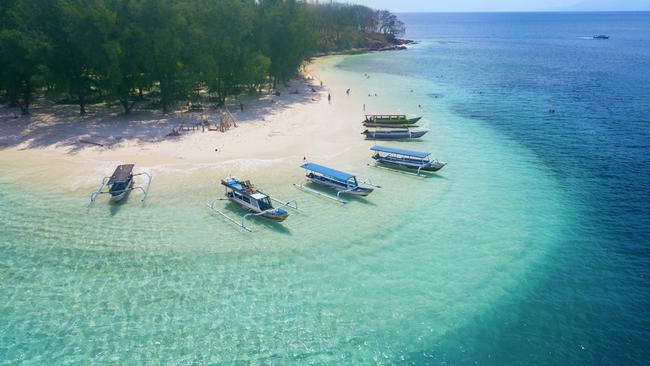Bali’s island neighbour a vision of tranquillity
You can get away from it all on Bali’s island neighbour without skimping on life’s luxuries.

Twenty years ago, I felt a midlife crisis coming on, so I pulled up stakes in Manhattan and moved to Indonesia, to give life in tropical paradise a try. I’ve divided my voluntary exile between Bali and its neighbour to the east, Lombok. I started in Bali, which has for centuries attracted dreamers and drifters seeking escape from industrial civilisation. The Balinese are both hospitable and canny marketers. They made their land a legend — “Island of the Gods” — and got rich catering to stressed-out foreigners. In my early days in Bali, I would rise at first light and ride my bike to Legian Beach for a swim, as dawn came booming up from the Indian Ocean.
Fifteen years later, Legian had become a tropical Coney Island, with a reputation for plastic garbage, rowdy bars and traffic jams that made cycling a dangerous proposition. Though I still love Bali, and for that matter, Coney Island, it’s not what I had in mind when I came here to live. So four years ago, my partner and I hopped across the strait to Lombok.
Now when I go for a swim, I share Batu Bolong Beach, near my house, with village kids leaping in the surf and sometimes even a few tourists — why not? Instead of the infinite sea, my view is dominated by Mount Agung, Bali’s irascible volcano, which looms across the strait, looking improbably tall and near.
My first visit to Lombok was in 1997. The national government realised Bali was getting overcrowded, so it decided to promote Lombok as an alternative destination, with an array of development projects, including a new international airport and generous incentives for building swanky resorts. An official in Mataram, the capital, confidently said Lombok was going to be the next Bali, a prediction I’ve since heard a hundred times. When I do, I recall Charles de Gaulle’s remark, “Brazil is the country of the future, and it always will be.”
It would be more accurate to say Lombok has become Bali as it was 30 years ago, before the boom. The island was developed for tourism just to the point that it offered a full range of services, and then started slowing down.
The impulse to get away from it all usually involves a degree of hypocrisy. We want to escape the hectic pace of Western cities and immerse ourselves in the simple life, but we’re not ready to give up a just-so cappuccino or the perfect daiquiri to complement the perfect beach.
Two of the finest beach resorts in the region face each other across a cove in northwest Lombok. The Oberoi Lombok is the masterpiece of Peter Muller, the Australian architect who pioneered the concept of the tropical luxury resort in Bali in the 1970s. The atmosphere is almost too tranquil, with lush lawns sweeping lazily into the offing. On Sire Beach, the Hotel Tugu Lombok is a lavish, eccentric tribute to the island’s Hindu heritage, and if it occasionally goes overboard, as it does with its spa installed in a full-scale Indian temple, why is that not fun?
In 2018, a 6.9 magnitude earthquake wrought widespread damage in northern Lombok; rebuilding is more or less complete. The price of accommodation plummeted after the quake, and it didn’t go up again. The south was unaffected and, off the southwest coast, a cluster of islets known as the South Gilis remain a global snorkelling destination.
Many visitors come to Lombok for mountain adventure. Mount Rinjani is a must-see for volcano-junkies; the second tallest in Indonesia, it has a crater lake in the shadow of the summit that’s stocked with hefty goldfish. Even in the dry season, the island abounds with waterfalls. My gardener belongs to a club that hikes to a different waterfall every Sunday, and he and his coterie are nowhere near the end of the list.
In guidebooks (remember them?) Lombok and Bali were often lumped together, with most of the pages devoted to Bali. The reasons for this linkage go beyond geographical proximity; the islands have been culturally continuous for centuries. Western Lombok was a part of the ancient Balinese kingdom of Karangasem, and many villages here follow the Hindu religion of Bali. The two islands complement each other well. Fast boats whiz back and forth across the strait on a trip that takes less than an hour when the sea is calm.
The beach where I swim takes its name from the Balinese temple that tops a rocky promontory at the southern end of the cove. Batu Bolong was built in 1533 by a Javanese mystic named Nirartha, who also founded Bali’s famous seaside temples of Tanah Lot and Uluwatu. On the full-moon holiday, I can hear the temple’s gamelan clanging away, competing with dance music at the bars on the other end of the beach.
Otherwise, it’s quiet here. The clubs close down early; the hottest DJs from Amsterdam and Ibiza don’t come to Lombok, but the sea turtles do. Here, life begins at dawn.
THE WALL STREET JOURNAL
